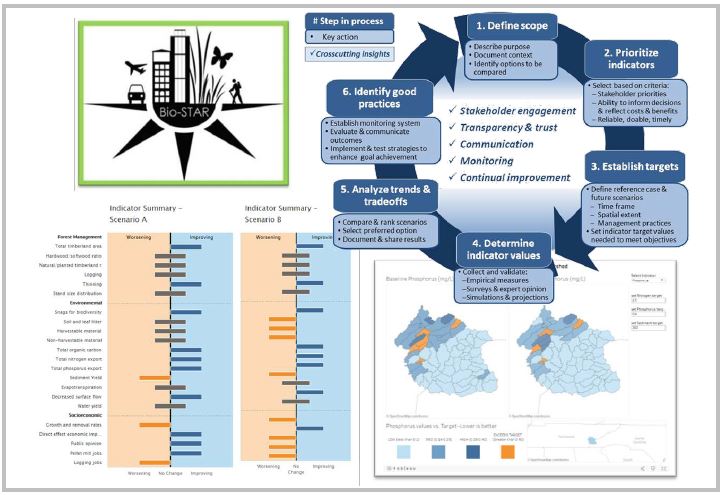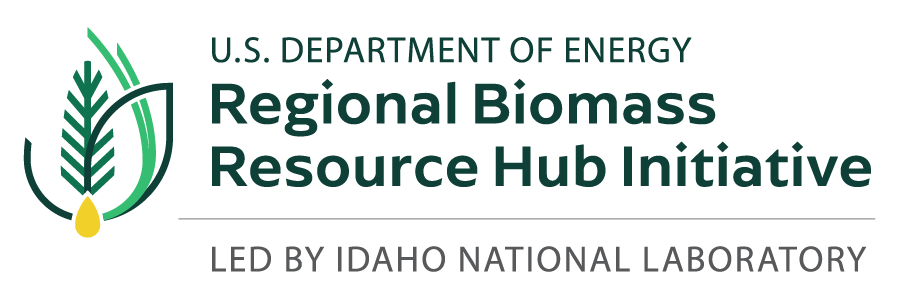Description
ORNL’s sustainability assessment approach for improved landscape management is based on decades of experience with stakeholders (Dale et al. 2019) and has been tested with three BETO-funded case studies: (1) Tennessee switchgrass production for ethanol, (2) Southeast US wood pellet production for bioenergy, and (3) Iowa landscape design to produce ethanol from switchgrass plantings and corn residues while improving ecosystem services. Case study results may be explored through the interactive Bioenergy Sustainability Tradeoffs Assessment Resource (BioSTAR) prototype on BioKDF (opens in new window). BioSTAR guides stakeholders through a sustainability assessment by (1) selecting key environmental and socioeconomic indicators of interest, (2) setting reasonable targets for each indicator, and (3) evaluating likely progress toward targets across alternative land management plans. BioSTAR’s integrates datasets from DOE (e.g., Billion Ton Volume 2 projections of water quality and carbon emissions under various bioenergy cropping scenarios) and other agencies (e.g., rural employment data from the US Census Bureau) with user-contributed indicator datasets to characterize potential changes in sustainability trajectories for bioenergy production scenarios relative to a reference case of no bioenergy production. This approach can help identify feedstocks and management practices that maximize benefits (e.g., soil carbon sequestration, improved water quality, new jobs) for local communities.
Capability Bounds
This sustainability analysis framework considers the choice of cellulosic feedstock (e.g., perennial grass, short rotation woody crop), field management, and transportation to the biorefinery gate. Effects are aggregated at landscape scales.
Unique Aspects
ORNL’s approach involves working with stakeholders to select and quantify key environmental and socioeconomic indicators for their local context. Additional indicators related to equity and environmental justice are currently under development.
Availability
The Bioenergy Sustainability Tradeoffs Assessment Resource (BioSTAR) tool has been developed by ORNL with support by BETO and is publicly available on BioKDF (opens in new window). BioSTAR is designed to help stakeholders quantify and visualize the potential sustainability benefits and tradeoffs of their own cellulosic biomass production systems.
Benefit
ORNL’s sustainability analyses quantify costs and benefits of US biomass production options at landscape scales, integrating environmental and socioeconomic indicators tailored to local conditions and stakeholder priorities. This approach maximizes benefits to US society (e.g., improvement of local water and soil quality, more value-added jobs) while minimizing negative impacts.
Capability Expert(s)
Esther Parish

References
Parish ES, Karlen DL, Kline KL, Comer KS, Belden WW (2023) Designing Iowa Agricultural Landscapes to Improve Environmental Co-Benefits of Bioenergy Production. Sustainability 15: 10051.
Parish E, Dale V, Davis M, Efroymson R, Hilliard M, Kline K, Jager H, Xie F (2021) An Indicator-based Approach to Sustainable Management of Natural Resources. Chapter 12 of Data Science Applied to Sustainability Analysis. Elsevier. 310 pages. Co-edited by Jennifer Dunn and Prasanna Balaprakash.
Dale VH, Kline KL, Parish ES, Eichler SE (2019) Engaging stakeholders to assess landscape sustainability. Landscape Ecology 34(6):1199-1218.
Parish ES, Dale VH, English BC, Jackson SW, Tyler DD (2016) Assessing multimetric aspects of sustainability: Application to a bioenergy crop production system in East Tennessee. Ecosphere 7(2):e01206. 10.1002/ecs2.1206
Efroymson RA, Dale VH, Kline KL, McBride AC, Bielicki JM, Smith RL, Parish ES, Schweizer PE, Shaw D (2013) Environmental indicators of biofuel sustainability: What about context? Environmental Management 51(2):291-306.
Parish ES, Hilliard M, Baskaran LM, Dale VH, Griffiths NA, Mulholland PJ, Sorokine A, Thomas NA, Downing ME, Middleton R (2012) Multimetric Spatial Optimization of Switchgrass Plantings Across a Watershed. Biofuels, Bioproducts & Biorefining 6(1):58-72.
McBride A, Dale VH, Baskaran L, Downing M, Eaton L, Efroymson RA, Garten C, Kline KL, Jager H, Mulholland P, Parish E, Schweizer P, Storey J (2011) Indicators to support environmental sustainability of bioenergy systems. Ecological Indicators 11(5): 1277-1289.
